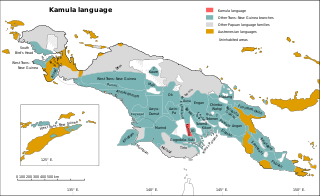
The Papuan languages are the non-Austronesian and non-Australian languages spoken on the western Pacific island of New Guinea, and neighbouring islands, by around 4 million people. It is a strictly geographical grouping, and does not imply a genetic relationship. The concept of Papuan peoples as distinct from Austronesian-speaking Melanesians was first suggested and named by Sidney Herbert Ray in 1892.
The East Papuan languages is a defunct proposal for a family of Papuan languages spoken on the islands to the east of New Guinea, including New Britain, New Ireland, Bougainville, Solomon Islands, and the Santa Cruz Islands. There is no evidence that these languages are related to each other, and the Santa Cruz languages are no longer recognized as Papuan.

West Papua, formerly Irian Jaya Barat or Irian Barat, is a province of Indonesia. It covers the two western peninsulas of the island of New Guinea, Bird's Head Peninsula and Bomberai Peninsula, along with nearby islands. The province is bordered to the north by the Pacific Ocean, to the west by the Halmahera Sea and the Ceram Sea, to the south by the Banda Sea, and to the east by the province of Papua and the Cenderawasih Bay. Manokwari is the province's capital, while Sorong is its largest city. West Papua is the second-least populous province in Indonesia, with a population of 1,134,068 at the 2020 Census.

The West Papuan languages are a proposed language family of about two dozen non-Austronesian languages of the Bird's Head Peninsula of far western New Guinea, the island of Halmahera and its vicinity, spoken by about 220,000 people in all. It is not established if they constitute a proper linguistic family or an areal network of genetically unrelated families.

The Mantion–Meax or (South)East Bird's Head languages are a language family of three languages in the "Bird's Head Peninsula" of western New Guinea, spoken by all together 20,000 people.
The Lower Mamberamo languages are a recently proposed language family linking two languages spoken along the northern coast of Papua province, Indonesia, near the mouth of the Mamberamo River. They have various been classified either as heavily Papuanized Austronesian languages belonging to the SHWNG branch, or as Papuan languages that had undergone heavy Austronesian influence. Glottolog 3.4 classifies Lower Mamberamo as Austronesian, while Donohue classifies it as Papuan. Kamholz (2014) classifies Warembori and Yoke each as coordinate primary subgroups of the South Halmahera–West New Guinea languages.
The Senagi languages are a small family of Papuan languages in the classification of Malcolm Ross, that had been part of Stephen Wurm's Trans–New Guinea proposal. They consist of the two languages Angor and Dera.

The North Bougainville or West Bougainville languages are a small language family spoken on the island of Bougainville in Papua New Guinea. They were classified as East Papuan languages by Stephen Wurm, but this does not now seem tenable, and was abandoned in Ethnologue (2009).
The East New Britain languages are a possible small language family spoken on the Gazelle Peninsula of New Britain in Papua New Guinea. They were classified as East Papuan languages by Wurm, but this does not now seem tenable. The only comparative work that has been done between the two branches of the proposed family is Ross (2001), which shows similarities in the pronouns.
Elseng is a poorly documented Papuan language spoken by about 300 people in the Indonesian province of Papua. It is also known as Morwap, which means "what is it?" ‘Morwap’ is vigorously rejected as a language name by speakers and government officials.

Sougb, or Sogh, is a Papuan language of the East Bird's Head language family spoken in the east of the Bird's Head Peninsula to the east of Meyah and to the south of Manokwari, including the area of Soug Jaya District, Teluk Wondama Regency. It consists of four dialects and is spoken by around 12,000 people in all. The language is alternatively known as Mantion, or Manikion, an originally derogatory term used by the Biak people.
Momuna (Momina), also known as Somahai, is a Papuan language spoken in the highlands of Papua province, Indonesia.

Mpur, is a language isolate spoken in and around Mpur and Amberbaken Districts in Tambrauw Regency of the Bird's Head Peninsula, New Guinea. It is not closely related to any other language, and though Ross (2005) tentatively assigned it to the West Papuan languages, based on similarities in pronouns, Palmer (2018), Ethnologue, and Glottolog list it as a language isolate.

Abun, also known as Yimbun, Anden, Manif, or Karon, is a Papuan language spoken along the northern coast of the Bird's Head Peninsula in Abun District, Tambrauw Regency. It is not closely related to any other language, and though Ross (2005) assigned it to the West Papuan family, based on similarities in pronouns, Palmer (2018), Ethnologue, and Glottolog list it as a language isolate.

Sumuri or Sumeri is a language spoken in Sumuri District, Teluk Bintuni Regency on the Bomberai Peninsula by about a thousand people.

Kamula is a Trans–New Guinea language that is unclassified within that family in the classification of Malcolm Ross (2005). Noting insufficient evidence, Pawley and Hammarström (2018) leave it as unclassified.

Massep is a poorly documented Papuan language spoken by fewer than 50 people in the single village of Masep in West Pantai District, Sarmi Regency, Papua. Despite the small number of speakers, however, language use is vigorous. It is surrounded by the Kwerba languages Airoran and Samarokena.
The Orya–Tor languages are a family of just over a dozen Papuan languages spoken in Western New Guinea, Indonesia.

Meyah (Meax) is a West Papuan language spoken in Miyah District, Tambrauw Regency of West Papua, Indonesia. The Meyah language is agglutinative and head-marking and has no grammatical cases. It has subject-object-verb word order, which comes from nearby Austronesian languages.
Hatam–Mansim is a small language family of New Guinea, consisting of two languages:










